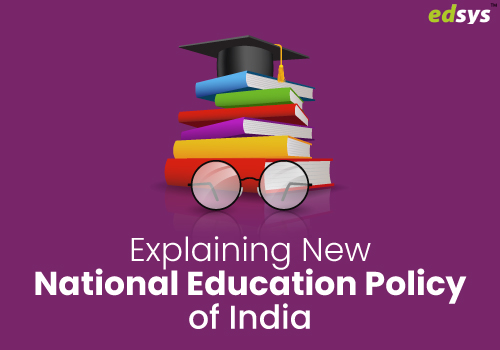Categories(658 Blogs)
Select Category
Watch Right Now
Teacher App - Class
Schedule & Attendance Management App
Parent App from Edsys

Best School Bus Tracking System

Cashless School - For Smart Schools of Tomorrow


New National Education Policy (NEP) of India 2020

It’s happening! The moment we have all been waiting for is at our doorsteps! Our current educational system in India is about to have a major revamp soon.
National Education Policy (or NEP) came as a surprise and it was a change that was long due. NEP was last updated in 1992, which is evidently pretty outdated.
“Our promising children will have a much more practical and useful education soon! Great news indeed!”
However, we do understand that many of you might be confused about the new announcement. So, what we have done here we have simplified the concept so that people can understand it easily and educate themselves.
In this blog we will address:
-
The Premises
-
Introduction
-
What is the National Educational Policy
-
History of National Educational Policy
-
Merits
-
Demerits
-
Conclusion
The Premises
The past system was increased compared to the ones in Finland, Singapore, and Germany. A major drawback of our system compared to them was that there was no flexibility in the subjects in a syllabus.
Students were forced to choose between Humanities, Commerce, and Science. Another major problem was the fact that there was little priority to practical knowledge.
This new policy by the Government of India has attempted to address all those drawbacks.
Let’s dive deep and see how the Government has tried to better the education sector.

Taken from The Hindu
Introduction
The new national education policy changes how schools, as well as colleges, work. It was put forward by Human Resource Development Ministry led by Hon’ble Education Minister, Shri Ramesh Pokhriyal ‘Nishank‘.
It is an attempt to revolutionize the curriculum, the courses offered and the medium of instruction. There have also been some controversial points, which we will discuss later on.
What is National Education Policy?
It is a framework by which all the educational institutions in India abides by. The policies get updated every few decades. This is by far, the most deviant from the older policies and hence the attention.
The History of National Education Policy
After the Independence of India, there have been many attempts to revive the quality of education. There were many commissions that aimed at this goal.
Some of the notable ones were:
- Education Commission – This was headed by UGC Chairperson, D S Kothari. The parliament passed the first education police in 1968 thanks to this commission
- Secondary Education Commission
- University Grants Commission
- Kothari Commission
As a result of these commissions, we have seen the birth of the Indian Institute of Technology (IITs) and the National Council of Educational Research and Training (NCERT). But we still didn’t have a solid ground on basic education.
That issue was addressed by the Indira Gandhi administration. They took into account the recommendations by the Kothari commission and made the National Education Policy.
That was the start of it all.
The policies were further revised by the Rajiv Gandhi administration and now by the Narendra Modi government.
Changes in Courses
There are no changes in the courses per se except for M. Phil programs. M. Phil’s are obsolete according to the policy
Pretty much everything else stays the same, except for the duration of courses. Degrees are now bumped up to 4 years and MA’s last only a year.
MA Graduates can now directly go for Ph.D. programs and all M. Phil programs will be phased out
No more UGC, AICTE, and NCTE
They will be replaced by a new body, known as the Higher Education Commission of India or HECI. This move is to govern private and public educational institutions by the same norms.
A new affiliation mechanism will grant autonomy to all colleges through a period of 15 years.
Also Read: 20 Best Education System in the World
The Positives/Merits
-
Flexibility
Like we mentioned earlier, one of the major drawbacks of the previous system was there was no flexibility in the subjects.
Focus on multi-disciplinary aspects, flexibility and more…some salient features of the National Education Policy, 2020. pic.twitter.com/yX1yaLMQ3k
— Narendra Modi (@narendramodi) August 1, 2020
There were specific curated subjects in Science, humanities and commerce that the student had no control over. But since the arrival of this policy there is more room for individuality.
A student studying in Humanities can study biology if s/he wants to, which was previously not possible. Students can build their own curriculum based on their interests.
-
Schools Start Early Now
A 5+3+3+4 instead of 10+2 model will be implemented
- This is another move on the right path. The government toll the initiative to give attention to children age 3-8. This allows the kids to get comfortable and start learning from a young age.
It ensures that everyone has the proper aptitude before entering into formal education. Activity-based learning takes place here. It will remind you of Finland’s education policy that gives priority to both work and plays.
- In the next three years (age 8-11), the children will transition into classroom learning while keeping activity-based learning alive.
- Age 11-14 (dubbed middle stage) will be concentrated on ‘experiential learning’ on Maths, Science, Arts, Humanities and Social Sciences.
- The next Secondary stage (14-18-year olds) is where they get to design their curriculum and the students will be allowed to cultivate very individuals’ skills and expand branches of their knowledge tree.
-
Vocational Learning
In India, there is a stigma against vocational jobs. Vocational jobs include carpentry, metalwork, etc. This is a wrong mindset and the government has tried to address it by introducing proper training.
A 10-day bagless period for grade 6-8 students will engage in internships under experts in the field. In the US, it is known as Shop Class, Germany is also a great example for vocational learning. This will continue towards 12th grade.
Apart from vocational learning, children will also learn coding from class 6. Which is a very important skill to possess in this day and age.
-
Report Cards
As a student we often feel that our report card is one-sided. But from now on the students are to self-evaluate themselves and their classmates.
This will bring a new perspective to everybody involved in the system. The students will also learn to critically think for themselves, giving them lessons of consequences from an early age.
These can help to raise citizens that self-assess themselves later on in their life.
-
Investment in Education
The best thing about New Education Policy: it says education will get 6% of GDP as against the present 1.7 per cent (quality needs to be focus now). overall, a policy that should be welcomed for its intent to at least take a serious look at a sector needing urgent reform.. 👍
— Rajdeep Sardesai (@sardesairajdeep) July 30, 2020
The government has promised that it will double the investment in this sector. That is approximately 3% of the GDP to 6%.
We have seen the budget go down throughout the years but the government came through and ensured more investment in the sector. In fact, the 6% calculation was already the goal of lawmakers from the start of our country.
This is definitely an achievement in that sense.
-
Board Examinations
The priority given to the Boards will be reduced. The policy aims to conduct 2 exams to reduce the burden and pressure.
The mode of examination will also be changed. You don’t have to have all the bookish knowledge to excel at exams anymore. The exams are to be more application based rather than ‘rote learning’.
There are breathing spaces for the students now.
-
Multiple Entries Exist Program
Students can now migrate between degree programs and carry their credits with them rather than just cancelling. You can also obtain certificates if you choose to drop out after a year.
- 1st year drop out – Certificate
- 2nd year – Diploma Certificate
- 3rd year – Bachelor’s Degree
- 4th year – Bachelor’s Research Degree
MA courses will last only one year of you complete all 4 years of Bachelor’s Degree.
The Negatives / Demerits
-
Medium of Instruction
The medium of education until class 5 will be the regional/mother language. The policy has ignored the importance of English as the unifying language of the country.
This rule can become a barrier because you will find it hard to cope with foreign language, especially English later on.
This also puts forward another problem. It will be impossible to transfer students between states as the children will be totally alien to other languages.
As much as unrealistic this is, we can expect this clause to not be implemented.
In a world where multilingualism is valued, this idea does more harm than good.
-
The Anti-Democratic argument
The policy has been criticized for not making the state governments participate in the system.
Bypassing Parliament, ignoring opinion of state governments and rubbishing opinions of all stakeholders, Modi government is unilaterally destroying our education system. pic.twitter.com/TxhS4GRzOi
— Sitaram Yechury (@SitaramYechury) July 29, 2020
The mechanism of education seems more centralized. Rather than leaving room for different states to modify the policy according to their needs and capability.
This will also affect teachers. The training board for teachers is also be set to be centralized.
The Wrap-up
These are pretty much an overview of the New National Education Policy. If you want to read the 66 paged government-issued pdf, you can do so by clicking this link.
We are yet to see the fruits of this new policy. We have to be skeptical about the implementation of this ambitious policy. But we should also be enthusiastic as there is a new goal in place.
Foreign universities have also been welcomed to set up schools here. This will improve the overall quality of education as there will be a tight competition.
Healthy competition can never go wrong, Am I right?
You can also expect students to have better mental health with a lightweight syllabus.
Recent Blogs
Our Educational Services
Popular Blogs
Subscribe

SUBSCRIBE TO OUR NEWSLETTER
Sign Up and Recieve the Latest News
Don’t Worry, We Don’t SpamExplore Our Extensive Researched Educational App Directory
Visit Now















